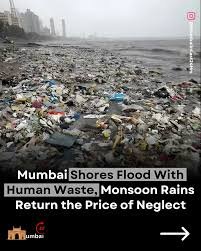As monsoon rains lash Mumbai, the city’s negligence comes full circle. Plastic, sewage, and garbage dumped into drains and rivers are now washing back onto the shores, flooding beaches with the very waste humans created. What was carelessly discarded has returned, reminding us that neglecting nature always carries a price.
Record Rainfall Brings City to a Halt
With over 280 mm of rainfall in just 24 hours, Mumbai has witnessed one of the heaviest downpours of the season. Suburban train services on both the Central and Western lines were suspended, major highways turned into rivers, and more than 150 flights were delayed or canceled. For millions of Mumbaikars, the city was effectively paralyzed.
Beaches Turn Into Dumping Grounds
The aftermath of the rains exposed Mumbai’s waste crisis in its starkest form. Over 952 metric tons of garbage were collected from Juhu, Versova, Dadar-Mahim, and other beaches within nine days. Plastic bottles, packaging material, sewage waste, and even household items resurfaced, carried back by tides from the very drains and rivers that had been used as dumping grounds.
The Mithi River: From Lifeline to Liability
Once a vital river that nourished communities, the Mithi today is an open sewer. Filled with sewage, industrial effluents, and plastic waste, it overflowed during the monsoon, spreading toxic sludge across neighborhoods. Environmentalists have long warned that neglecting the Mithi is equivalent to inviting disaster—and this year’s floods have proven them right yet again.
Infrastructure Fails, Citizens Fume
The Brihanmumbai Municipal Corporation (BMC) once again came under fire. Despite the BRIMSTOWAD project—promised to upgrade Mumbai’s century-old drainage system—the city still has infrastructure that can only handle 25 mm of rain per hour, far less than the 80–100 mm witnessed in recent spells. Newly built structures like the Vikhroli rail overbridge also saw waterlogging, exposing poor planning and execution.
Social media was flooded with images of waist-deep water at Goregaon’s Oberoi Mall, waterlogged housing societies in Powai, and power outages at hospitals. Hashtags like #MumbaiFloods2025 and #AccountabilityNow trended as citizens demanded accountability.
Health and Economic Fallout
Public health experts warn of a spike in dengue, leptospirosis, gastroenteritis, and malaria in the coming weeks. Overflowing sewage has already mixed with drinking water pipelines in parts of Dharavi and Kurla, raising alarms of contamination. Economically, the city has faced losses worth crores, with halted trading activity, disrupted supply chains, and a surge in insurance claims for damaged property and vehicles.
The People Respond
While authorities scramble, citizens are stepping up. Environmentalist Afroz Shah and his volunteers have resumed large-scale cleanups at Versova and other beaches. NGOs are distributing drinking water and food to stranded residents. Community kitchens have emerged in low-lying neighborhoods to support flood-hit families, proving yet again that when systems fail, people rise to the occasion.
A Wake-Up Call for Mumbai
This year’s monsoon has once again exposed the fragile balance between urban expansion and environmental neglect. Mumbai cannot afford to treat this as an annual disaster. What is needed is a complete overhaul of waste management, strict enforcement against plastic dumping, investment in climate-resilient infrastructure, and citizen participation on a massive scale.
Conclusion
Mumbai’s monsoon floods are no longer “natural disasters”—they are man-made crises. Until the city acknowledges that its carelessness is the root cause, each year will bring the same images of drowned trains, flooded homes, and garbage-strewn beaches. The rains are not the enemy—our negligence is.
FOR MORE BLOGS – beyondthepunchlines.com

 Add to favorites
Add to favorites







